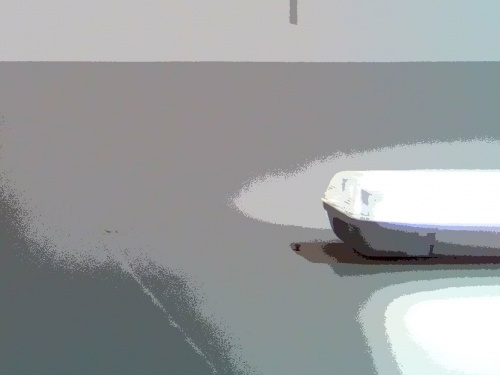ICA Student Forum: Reflections on art in the age of machine learning
Why new technologies tend to imitate nature and how art can help us cope with fears of the unknown
This post is part of a Bulletin series dedicated to the ICA Student Forum and designed to enable forum members to showcase their ideas across the ICA’s digital platforms, innovating and experimenting. In 2017, in addition to co-curating and delivering events, talks and workshops as part of the ICA Public Programme, Student Forum members are working to generate a self-published zine to be launched in December 2017. Reflecting the Forum’s myriad of talents, interests and ideas, the zine consists of four themes: Performance, Technology, Sound, and Rituals & Non-Spaces.
In this post, the ICA Student Forum invited curator Felice Moramarco to share thoughts on the Western tendency to anthropomorphise technological unknowns. The post is supported by images from 4scifi by Natalia Trejbalova.
Among the many narratives of the Technological Singularity, the one theorising the endangerment of human life consequent to the rise of machine consciousness has gained immense popularity. According to it, the development of artificial intelligence will reach a point where machines are conscious and can pursue their own ends that will inevitably clash with those of humans, causing a struggle in which humans will inevitably succumb.
Cinema has often represented this dystopian scenario set in the future. From the supercomputer HAL 9000 in 2001: A Space Odyssey (1968), who attempts to terminate the crew after concluding that humans threaten the fulfilment of his programmed task, to the intelligent machines of The Matrix (1999), which exploit humans as sources of bioelectrical power, to Ava, the cyborg in Ex Machina (2015), who disguises herself as an attractive woman, seduces the engineer that is testing her intellectual abilities and kills him in order to gain freedom. Apparently, to liberate herself from the control of humans, a cyborg does not find any better solution than playing the well-worn role of the ruthless femme fatale.
It is quite evident that the popular imagination is still unable to represent a form of advanced intelligence that is not in the image of the human one. This follows the Western trend to anthropomorphise the unknown. “What was once attributed to the obscure and infinite night”—argues philosopher Matteo Pasquinelli—“is now projected onto the abstract abyss of computation, data centres, and machine learning”.
It is quite evident that the popular imagination is still unable to represent a form of advanced intelligence that is not in the image of the human one.
Besides, the history of technology shows that in its early stages, before new inventions started developing their own set of engineering principles, new innovations tended to take shape by imitating either nature or previous forms. It took decades before cars stopped looking like carriages without horses and centuries before airplanes replaced clumsy flying machines with flapping wings. Similarly, artificial intelligence has been moulded by imitating the human brain. Despite AI having already developed its own ways of cognition, differentiated from that of humans, the popular imagination still struggles with representing its own specificity.
The reason is quite obvious: Western culture has been shaped for millennia around a hierarchical order that has had the rational subject—embodied by the white adult male—on top. The significance attributed to this subject has increasingly grown through the Enlightenment to the point where it became the necessary condition for the existence of reality itself. Remarkably, for the German philosopher Johann Gottlieb Fichte, the world was divided between I and non-I. His student Friedrich Hegel pushed things even further: reality is the result of the self-actualising mind. In short, there is no reality without a rational subject. In such a contest, it is obviously hard to accept the emergence of non-human intelligence.
Further, Reason has always been the tool through which Western culture approached the unknown. It has in fact usually been metaphorically associated with Light, as Reason is meant to ‘enlighten’ the unknown and turn it into an object to be measured, analysed and understood by the subject. This becomes an impossible task however, when the unknown object is another form of subjectivity which cannot be known by reducing it to a clear finite set of elements to measure, analyse and understand, as it is in a constant process of becoming and evolving in unforeseeable ways.
Conscious or not, AI already affects many aspects of our lives. If we want to avoid being overwhelmed by it, we must find a way to deal with it that is not based on intellectual understanding: a space that does not have fixed structures and can comprise the unpredictability of the unknown, in which different forms of subjectivity can coexist and affect each other, without one being reduced to the form of the other.
The progress of Western civilisation has dismissed the aesthetic as irrational and its removal has caused the power trip of the subject.
The aesthetic is the dimension in which such space can be created. Being a field of affects that precedes the subject and gives rise to it, the aesthetic inextricably links it with its surrounding environment. Yet, the progress of Western civilisation has dismissed the aesthetic as irrational and its removal has caused the power trip of the subject. Setting itself up as omnipotent, the subject becomes blind and paranoid. Anything that escapes its understanding and emerges as an alternative to itself is depicted as a danger that can cause catastrophes.
In the last pages of Aesthetic Theory, Theodor W. Adorno identifies what he calls the “aesthetic comportment” at the origin of art. This is a way of establishing a relation with the other through mimesis, i.e. becoming like the other. Even though the latter is not understood and remains unknown, the aesthetic comportment creates erotic connections among subjects that mutually effect each other. The aesthetic comportment, Adorno writes, is “the capacity to shudder” when touched by the other, “as if goose bumps were the first aesthetic image”. Art in fact liberates the subject from the fear of those shudders - it “joins eros and knowledge”.
Art dissolves the fear and paranoia of the subject towards the other. Art openly faces the unknown and moves into it with the same audacity of the explorer that ventures in unexplored lands without maps, looking for things that no one has ever seen before. Art does not explain the unknown, but it allows it to be experienced. By doing so, art shakes the subject, reviewing its position and liberating it from the obligation to be unique, which can finally reconjoin with what is different from itself. Hence, only art can turn the fear of the rise of artificial intelligence into a principle of emancipation. ■
This article is posted in: Articles, Student Forum
Tagged with: Felice Moramarco, ICA Student Forum, AI, Artificial Intelligence, aesthetics, Theodor Adorno, philosohpy









